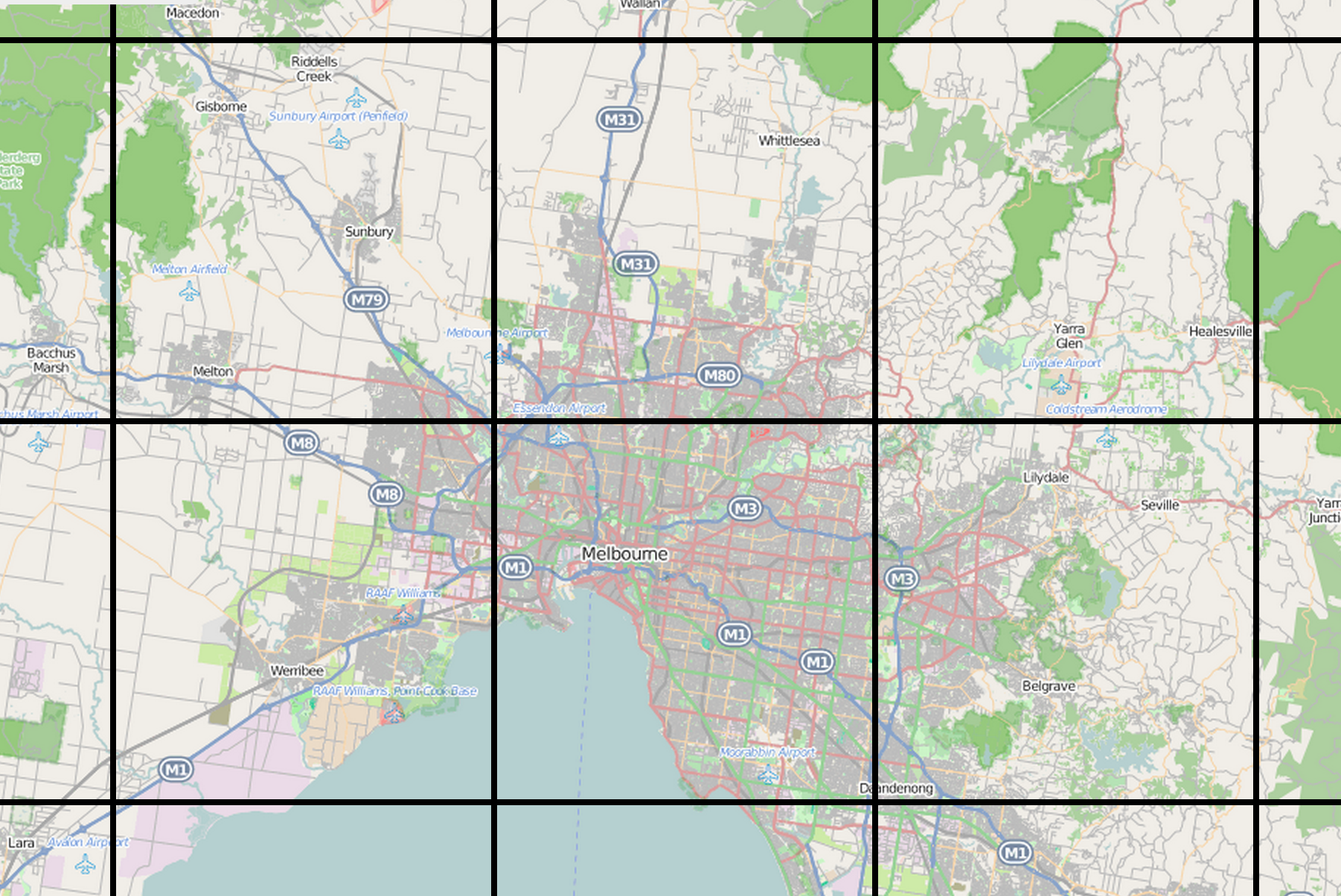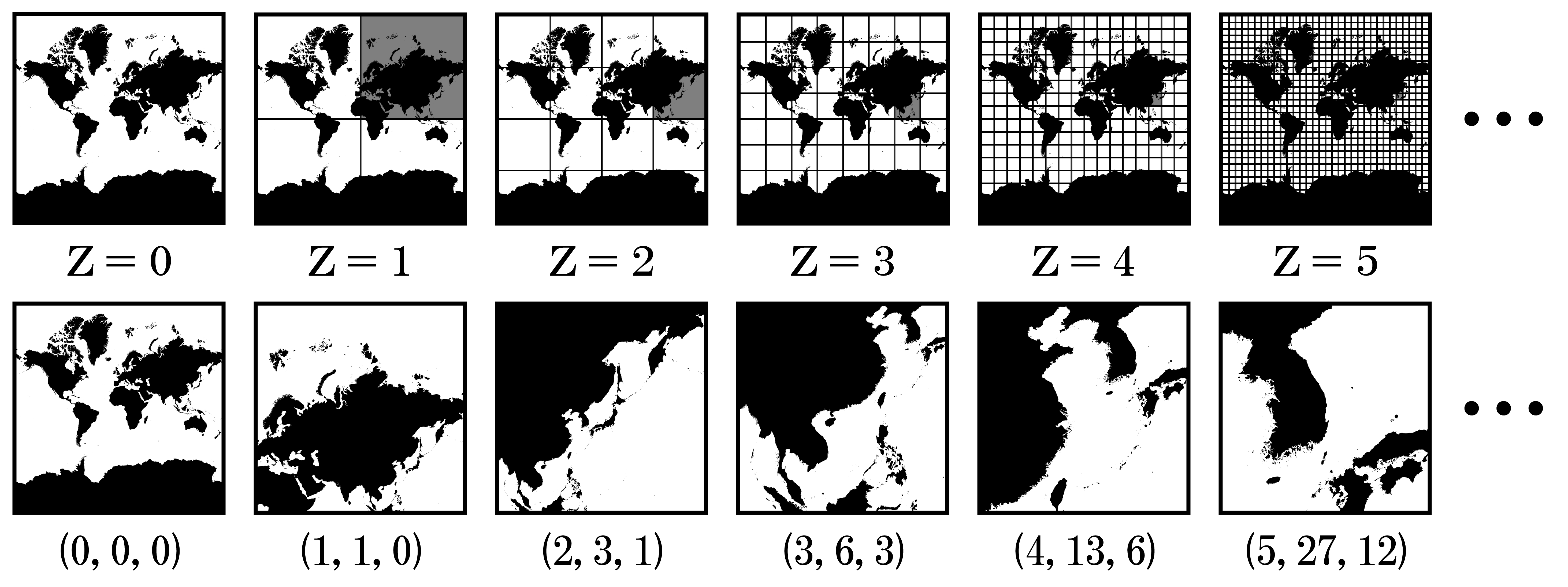Tiled Web Map on:
[Wikipedia]
[Google]
[Amazon]
 A tiled web map or tile map (also known as slippy map in
A tiled web map or tile map (also known as slippy map in
 Properties of tiled web maps that require convention or standards include the size of tiles, the numbering of zoom levels, the projection to use, the way individual tiles are numbered or otherwise identified, and the method for requesting them.
Most tiled web maps follow certain Google Maps conventions:
* Tiles are 256x256 pixels
* At the outer most zoom level, 0, the entire world can be rendered in a single map tile.
* Each zoom level doubles in both dimensions, so a single tile is replaced by 4 tiles when zooming in. This means that about 22 zoom levels are sufficient for most practical purposes.
* The Web Mercator projection is used, with latitude limits of around 85 degrees.
The de facto OpenStreetMap standard, known as Slippy Map Tilenames or XYZ, follows these and adds more:
* An X and Y numbering scheme
* PNG images for tiles
* Images are served through a
Properties of tiled web maps that require convention or standards include the size of tiles, the numbering of zoom levels, the projection to use, the way individual tiles are numbered or otherwise identified, and the method for requesting them.
Most tiled web maps follow certain Google Maps conventions:
* Tiles are 256x256 pixels
* At the outer most zoom level, 0, the entire world can be rendered in a single map tile.
* Each zoom level doubles in both dimensions, so a single tile is replaced by 4 tiles when zooming in. This means that about 22 zoom levels are sufficient for most practical purposes.
* The Web Mercator projection is used, with latitude limits of around 85 degrees.
The de facto OpenStreetMap standard, known as Slippy Map Tilenames or XYZ, follows these and adds more:
* An X and Y numbering scheme
* PNG images for tiles
* Images are served through a
Example of a tiled marine map for boating
Web mapping
 A tiled web map or tile map (also known as slippy map in
A tiled web map or tile map (also known as slippy map in OpenStreetMap
OpenStreetMap (abbreviated OSM) is a free, Open Database License, open geographic database, map database updated and maintained by a community of volunteers via open collaboration. Contributors collect data from surveying, surveys, trace from Ae ...
), is a web map displayed by seamlessly joining dozens of individually requested data files, called "tiles". It is the most popular way to display and navigate maps, replacing other methods such as Web Map Service
A Web Map Service (WMS) is a standard protocol developed by the Open Geospatial Consortium in 1999 for serving georeferenced map images over the Internet. These images are typically produced by a map server from data provided by a GIS database ...
(WMS) which typically display a single large image, with arrow buttons to navigate to nearby areas. Google Maps
Google Maps is a web mapping platform and consumer application offered by Google. It offers satellite imagery, aerial photography, street maps, 360° interactive panorama, interactive panoramic views of streets (Google Street View, Street View ...
was one of the first major mapping sites to use this technique. The first tiled web maps used raster tiles, before the emergence of vector tiles.
There are several advantages to tiled maps. Each time the user pans, most of the tiles are still relevant, and can be kept displayed, while new tiles are fetched. This greatly improves the user experience, compared to fetching a single map image for the whole viewport. It also allows individual tiles to be pre-computed, a task easy to parallelize. Also, displaying rendered images served from a web server is less computationally demanding than rendering images in the browser, a benefit over technologies such as Web Feature Service (WFS). While many map tiles are in raster format (a bitmap file such as PNG or JPEG
JPEG ( , short for Joint Photographic Experts Group and sometimes retroactively referred to as JPEG 1) is a commonly used method of lossy compression for digital images, particularly for those images produced by digital photography. The degr ...
), the number of suppliers of vector tiles is growing. Vector tiles are rendered by the client browser, which can thus add a custom style to the map. Vector map tiles may also be rotated separately from any text overlay so that the text remains readable.
Defining a tiled web map
 Properties of tiled web maps that require convention or standards include the size of tiles, the numbering of zoom levels, the projection to use, the way individual tiles are numbered or otherwise identified, and the method for requesting them.
Most tiled web maps follow certain Google Maps conventions:
* Tiles are 256x256 pixels
* At the outer most zoom level, 0, the entire world can be rendered in a single map tile.
* Each zoom level doubles in both dimensions, so a single tile is replaced by 4 tiles when zooming in. This means that about 22 zoom levels are sufficient for most practical purposes.
* The Web Mercator projection is used, with latitude limits of around 85 degrees.
The de facto OpenStreetMap standard, known as Slippy Map Tilenames or XYZ, follows these and adds more:
* An X and Y numbering scheme
* PNG images for tiles
* Images are served through a
Properties of tiled web maps that require convention or standards include the size of tiles, the numbering of zoom levels, the projection to use, the way individual tiles are numbered or otherwise identified, and the method for requesting them.
Most tiled web maps follow certain Google Maps conventions:
* Tiles are 256x256 pixels
* At the outer most zoom level, 0, the entire world can be rendered in a single map tile.
* Each zoom level doubles in both dimensions, so a single tile is replaced by 4 tiles when zooming in. This means that about 22 zoom levels are sufficient for most practical purposes.
* The Web Mercator projection is used, with latitude limits of around 85 degrees.
The de facto OpenStreetMap standard, known as Slippy Map Tilenames or XYZ, follows these and adds more:
* An X and Y numbering scheme
* PNG images for tiles
* Images are served through a Web server
A web server is computer software and underlying Computer hardware, hardware that accepts requests via Hypertext Transfer Protocol, HTTP (the network protocol created to distribute web content) or its secure variant HTTPS. A user agent, co ...
, with a URL like http://.../Z/X/Y.png Tile numbering schemes
There are three main numbering schemes in use: * Google Maps / OpenStreetMap: (0 to 2zoom-1, 0 to 2zoom-1) for the range (−180, +85.0511) - (+180, −85.0511) * Tile Map Service: (0 to 2zoom-1, 2zoom-1 to 0) for the range (−180, +85.0511) - (+180, −85.0511). (That is, the same as the previous with the Y value flipped.) * QuadTrees, used by Microsoft.Standards
Several standards exist: * Tile Map Service: an early standard supported by OpenLayers. One difference is the y axis is positive northwards in TMS, and southwards in OpenStreetMap. * Web Map Tile Service: a more recentOpen Geospatial Consortium
The Open Geospatial Consortium (OGC) is an international voluntary consensus standards organization that develops and maintains international standards for geospatial content and location-based services, sensor web, Internet of Things, Geographi ...
(OGC) standard.
* The de facto XYZ standard referred to above.
* TileJSON: a lightweight JSON
JSON (JavaScript Object Notation, pronounced or ) is an open standard file format and electronic data interchange, data interchange format that uses Human-readable medium and data, human-readable text to store and transmit data objects consi ...
description of all the parameters associated with a web map, created by Mapbox.
* Bing Maps Tile System, using Quadkeys for addressing.
Client libraries
To display a tiled map in a browser usually requires the support of aweb mapping
Web mapping or an online mapping is the process of using, creating, and distributing maps on the World Wide Web (the Web), usually through the use of Web GIS, Web geographic information systems (Web GIS). A web map or an online map is both served ...
framework. This framework handles the retrieval of tiles, display, caching, and user navigation. Popular frameworks for tiled maps include Google Maps API, OpenLayers and Leaflet.
References
External links
*{{cite web, url=https://www.mapbox.com/foundations/how-web-maps-work/, title=How do Web Maps Work?, publisher=MapboxExample of a tiled marine map for boating
Web mapping